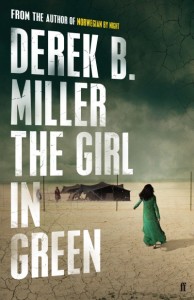The Girl in Green – Derek B. Miller
 On what scale do you measure the tragedy of modern war? That of hundreds of thousands of deaths, military and civilians alike? Of millions of refugees? ‘The Girl in Green’ by Derek B. Miller will give you a glimpse of the big numbers, taking you from war-torn Iraq in 1991 to 2013 Iraqi Kurdistan, in and around the Domiz refugee camp in Dohuk, where the collateral damage from the Syrian civil war and from the brutal birth-throes of the self-styled ISIS caliphate are scattering the old, the young, the destitute and the defenceless. A UN High Commission for Refugees (UNHCR) website gives current figures for the refugees in the Dohuk area and, by any term of reference, the numbers are staggering.
On what scale do you measure the tragedy of modern war? That of hundreds of thousands of deaths, military and civilians alike? Of millions of refugees? ‘The Girl in Green’ by Derek B. Miller will give you a glimpse of the big numbers, taking you from war-torn Iraq in 1991 to 2013 Iraqi Kurdistan, in and around the Domiz refugee camp in Dohuk, where the collateral damage from the Syrian civil war and from the brutal birth-throes of the self-styled ISIS caliphate are scattering the old, the young, the destitute and the defenceless. A UN High Commission for Refugees (UNHCR) website gives current figures for the refugees in the Dohuk area and, by any term of reference, the numbers are staggering.
There is another, no less poignant scale through which Miller has chosen to measure the horror though: that of the single individual. Arwood Hobbes, a US soldier sitting out the immediate aftermath of ‘Desert Storm’ on the Iraqi front-line. Thomas Benton, a British war journalist. The girl in green, a nameless young girl from the Iraqi village of Samawah whom the pro-Saddam forces shoot before Hobbes’ and Benton’s eyes in 1991. Marta Ström, a Swedish project officer working for the UNHCR and stationed at Dohuk, who befriends Hobbes and Benton, having a brief fling with the latter. A Western-educated Syrian man washed up at the Dohuk camp in 2013 after his pregnant wife was killed by a government sniper – a double kill meaning double reward – whom Benton briefly talks to.
The list is long and harrowing: Miller has measured the horror of violent conflict through the individual lives affected by it, pulling no punches in doing so. With ‘The Girl in Green’, his second novel after the success of ‘Norwegian by Night’, he has fashioned a unique, label-defying creation. It is at once a taut thriller, a clever psychological study of a man’s obsession, the story of a journey through a brutally savaged land, a stark denunciation of the horror of civil war and the refugee disaster in Syria, Iraq and Kurdistan, a piercing reflection on how socio-political value judgements can be both futile and spectacularly wrong if history and culture are ignored.
It is a heady cocktail, and a risky one to blend. Miller rises superbly to the challenge though, crafting a perfectly balanced story in which the personal and the historical, the familiar and the unfamiliar, the absurd and the common sense, all miraculously cohabit. To further raise the authorial stakes, Miller chose to lace the narrative with a discreet vein of wry irony, if not humour. More of an echo really, but enough to avoid an all-too-easy slide into melodrama, given the premises of the story are so tragic, or super-hero antics, given that the novel’s protagonists regularly find themselves in life-and-death circumstances.
For all the subtlety that Miller has woven into his narrative, the plot of ‘The Girl in Green’ is quite simple. Twenty two years after the original girl in green was shot under Hobbes’ and Benton’s eyes in Iraq, Hobbes contacts Benton out of the blue and enlists him on a search for the girl. He claims to have seen her again, alive, on the video of an ISIS attack on Iraqi refugees which was broadcast worldwide. Benton is in his sixties, and both his personal life and career are terminally winding down. To heed his old friend’s call is to close a door on the present and search for a new future, perhaps by redeeming the past. So he agrees to meet Hobbes in Dohuk, where they find a host of old friends: Marta, still very active in aid work, in fact much higher up the hierarchy, Herb and Tigger (a nickname), a US and French former NATO-mission soldiers who, like Marta, Hobbes and Benton, are still enmeshed in the Iraqi-Syrian tragedy.
Hobbes is a man on a mission, obsessed and obsessive, but the essential human appeal of what he wants to do is enough to cajole or coerce his friends into the search, and to overcome the near-insurmountable logistics of seeking out a shadow of a woman, very likely dead in an ISIS mortar attack, inside a civil war-torn area where allegiances shift every day. All of this in the face of an Iraqi attack on ISIS forces, while both Kurdish Peshmerga insurgents and the ancient settlers of this tragic patch of land, the enigmatic Yezidis, watch on.
It is a mad quest, but is it any madder than the reciprocal ethnic slaughter of the Sunni/Shia/Kurds/Yezidi, than Western aid workers wanting to remain there to offer their drop of relief against the tidal wave of displacement, than an international army under the UN flag wanting to make peace with guns and tanks, than Red Cross and Red Crescent medical personnel, among others, wanting to care for the sick and the wounded from all the sides of the labyrinthine conflict?
Miller’s answer is ‘no’, that Hobbes’ and Benton’s quest for the girl in green isn’t any madder, and as such it is justifiable, it doesn’t even require the reader’s suspension of disbelief. Because if it wasn’t so, then very little of what goes on in our lives would be justifiable.
And so the search party leaves Dohuk, protected by technology, hope and instinct in equal measure, driven by a local driver, Jamal, for whom this is just another day’s work, with another day’s prospect of violent death at the end of it. As Hobbes and Benton push deeper into the war zone, Miller takes the reader deeper into their minds and their relationship, exposing unsuspected motivations. Both the former US soldier and the British journalist are hiding something, from themselves as much as from one another. And the more dangerous the quest becomes, as they come face to face with ISIS militants, and the closer they are to saving the girl in green, the greater is the peril from the ways each has of dealing with his own phantoms.
Another of the successes of ‘The Girl in Green’ is how cleverly Miller renders the delicate web of personal relationships that sustain the protagonists’ lives. From friend, to acquaintance to lover to a whole series of new categories binding together men and women who live on a daily knife edge of violence, helplessness and utter lack of resources. All of them at constant risk, even those who are apparently the most powerful.
No one in this brilliant, breathless and insightful novel is safe. No one is safe from humanity’s collective madness just as none of us is safe from his or her own mind. It is a stark conclusion that Miller reaches, but one that, after reading ‘The Girl in Green’, one might be justified to reach for even the most ordinary situations in life. Derek B. Miller has given us an outstanding story, showing how the border between the ordinary and the extraordinary can be blurred, both by circumstances and by personal motivations. There is always a basic core of humanity within each one of us – though sometimes we try hard to conceal it.




